4K Blu-ray Players and Discs—Are You Ready?
Spring is bringing more than just flowers next year. The Blu-ray Disc Association (BDA) has announced that a new Blu-ray Disc standard is coming that will take into account the emerging 4K Ultra-HD (UHD) format. They don’t expect retail BD movies in 4K until Christmas of 2015, but the announcement answers a lot of questions users have been asking—namely, “Where is the 4K content to go with these new TVs?” Great question, and it’s nice to start finally getting some answers.
The BDA is determined to push the physical Blu-ray format. With 4K they seem to have a fighting chance as streaming 4K content will take a lot more bandwidth than most households are consuming currently. It’s not that the Internet isn’t fast enough—it’s just that we have placed a lot of demands on our networks. Streaming 4K content on top of that over the Internet is going to be a big concern for both content providers as well as service providers. Netflix has stated streaming 4K content, but it’s costing new subscribers more money and it’s limited in scope—severely limited. Currently only House of Cards, Breaking Bad, and some generic nature videos are available for 4K streaming.
One advantage of using Blu-ray as a delivery mechanism for 4K content is the absence of skipping, stuttering, and clogging up network bandwidth. If everyone started streaming 4K content to their new televisions I’d suspect Internet data rates would start to go up as a result—or throttling would occur during prime time viewing hours. I would think that once the format arrives in full bloom, companies like Netflix will step up and provide a direct-to-home service for consumers similar to what they currently offer.
4K Blu-ray: What We Know So Far
Features/Specs | 4K Blu-ray | Blu-ray Disc |
| Storage(single/dual layer) | 50GB/66GB/100GB | 25GB/50GB |
| Laser type | 405nm (blue laser) | 405nm (blue laser) |
| Video bit rate | 50.0Mbps+ | 40.0Mbps |
| Data transfer rate | ??? | 54.0Mbps |
| Video resolution | 3840 x 2160 (4K) @ 60fps | 1920×1080 (1080p) |
| Video bit depth | 10-bit | 8-bit |
| Video codecs | H.265/HEVC MPEG-2 MPEG-4 AVC SMPTE VC-1 | MPEG-2 H.264/MPEG-4 AVC SMPTE VC-1 |
| Audio codecs | Linear PCM Dolby Digital DTS Digital Surround Dolby Digital Plus Dolby TrueHD DTS-HD | Linear PCM Dolby Digital DTS Digital Surround Dolby Digital Plus Dolby TrueHD DTS-HD |
| Audio channels | 32 | 8 |
| Interactive Features | BD-J (BD-Java) | BD-J (BD-Java) |
Existing 50GB discs will support the new 4K content, but the Blu-ray Disc Association will also pave the way for 66GB and 100GB discs as well. And they’ll need to as an extended edition of the The Hobbit: The Battle of the Five Armies in 4K resolution is going to blow away a traditional 50GB disc. The new format is also going to support higher frame rates of up to 60 frames per second, which should make Peter Jackson happy (who pioneered using the 48Hz double frame rate in The Hobbit: An Unexpected Journey). To make 4K possible and not blow away disc space, the new 4K Blu-ray discs will use High Efficiency Video Coding (HEVC), a video compression standard that improves upon H.264/MPEG-4 AVC. Interestingly, 4K Blu-ray will also support HDR (High-Dynamic Range as well as the new Rec. 2020 color gamut.
Their work is certainly cut out for them. As more and more consumers wait for the new format, the outlook on 4K is a bit chicken-and-egg. If 4K goes the way of 3D, you can expect more and more models to integrate the higher resolution displays without much fanfare—almost as an expected new feature or standard, regardless of whether or not it’s being used. If, however, consumers reject 4K sales until more material is available, then streaming 4K may take the lead before the hardware can keep up.
One thing is for certain: All eyes will be on the BDA come next Spring. Will you be in line or standing on the sidelines?







will the new 4k discs include 3d? all the specs i have seen haven’t mentioned 3d at all
My guess is they’ll include some form of 3D content, though it won’t likely be at full 4K resolution at 60Hz (basically, it can’t double the max bandwidth).